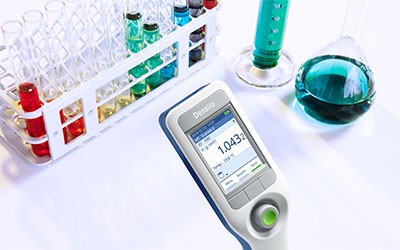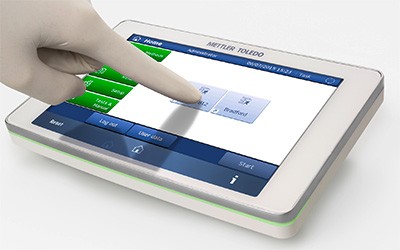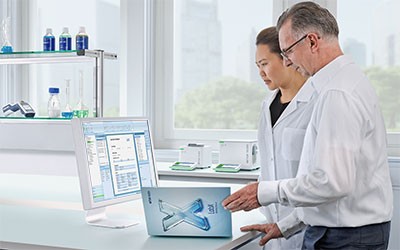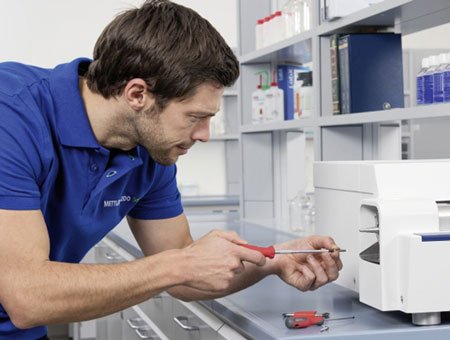We support and service your measurement equipment through its entire life-cycle, from installation to preventive maintenance and calibration to equipment repair.
Please choose your equipment type:

A density meter, also known as densimeter or specific gravity meter, is an analytical instrument that uses the oscillation of a U-shaped hollow glass tube to measure the density of liquid samples quickly and automatically. The measured density can then be automatically converted into other units and concentrations for specific applications, as specific gravity, API, alcohol%, Brix and many more. Choose your density meter from the lightest portable option to the most accurate benchtop model.

No matter your industry, from pharmaceuticals to petrochemicals to food and more, our density meters can measure any sample. Volatile, corrosive, viscous and pasty substances can all be reliably measured.

As confirmed by a customer: “The density meter is very easy to use, we only need to add the sample and tap the One Click shortcut—then the entire task is quickly completed. After having worked with a density meter and an autosampler since 2017, we purchased a second system in 2019 to increase our throughput”, QA manager, Solvay (Zhenjiang) Chemicals, China.

The unique software solutions ensure efficient electronic data management, connectivity with multiple instruments, central control of resources, data integrity and much more.

Thousands of happy customers worldwide – from family-owned companies to multinationals. Our instruments are built to perform and offer every customer reliable and efficient quality control.

From the lightest portable density meter weighing only 355 g (12.5 oz), to the most compact benchtop meter, our instruments are designed to improve the user experience by reducing hand strain and saving bench space.

Engineered with high quality components to ensure a long lifespan, our density meters can withstand harsh environments in the laboratory, on the factory floor, or on the go!

You can rely on our service technicians and application experts to support you in the areas you need it the most. From ensuring maximum uptime with preventative maintenance to user training and consultations.

We support and service your measurement equipment through its entire life-cycle, from installation to preventive maintenance and calibration to equipment repair.
Please choose your equipment type:

Digital density meters (specific gravity meters) use a U-shaped hollow glass tube, which is put into oscillation. The oscillation frequency of the tube filled with the sample is measured. This frequency changes when the tube is filled with the sample: the higher the mass of the sample, the lower the frequency. This frequency is measured and converted to density. In addition, benchtop digital density meters use a built-in Peltier thermostat to control the temperature of the sample.
A specific gravity meter, density meter or densimeter refers to the same instrument. Different terms are used depending on the country or region in which it is used. This instrument uses oscillating U-tube technology to measure specific gravity, density or related values in a liquid sample. This measurement is performed automatically, reducing operator influence and improving repeatability.
The density of a solution can be measured manually or digitally. For more detailed information on how to measure density with pycnometers, hydrometers and digital density meters please see our 3 Ways to Measure Density guide.
Manual methods like pycnometers and hydrometers are widely used for the determination of density and related values, e.g. specific gravity, alcohol%, BRIX°, API degrees, Baumé, Plato, etc. Although these methods are easy to use and quite inexpensive, they require expertise in every step of manual operation protocols, which often affects the accuracy and reliability of the results.
A pycnometer is a glass beaker of defined volume. It is weighed without the sample (M1), then filled with the sample and weighed again (M2). The difference between M1 and M2 divided by the volume of the beaker is the density of a sample.
A hydrometer is a glass body which is dipped into the sample. After a short equilibration time it will float a certain level. The higher the density of the sample, the less the hydrometer will float. The level of equilibration reads the density.
A density kit is used with a balance. A glass body of defined volume is weighed in air (M1), dipped into the sample and weighed again in the sample (M2). The difference between M1 and M2 (buoyancy) divided by the volume of the glass body is the density of the sample. A special holder can also be used to measure the density of solids using a reference liquid (water, ethanol or user defined).
Digital density meters, also known as specific gravity meters or densimeters, are available as benchtop and handheld instruments. They use oscillation tube technology to very accurately measure the density of a sample in a short timeframe. A hollow glass tube vibrates at a certain frequency. This frequency changes when the tube is filled with the sample: the higher the mass of the sample, the lower the frequency. This frequency is measured and converted to density. In addition, benchtop digital density meters use a built-in Peltier thermostat to control the temperature of the sample.
For more information on digital density meters and how they compare to manual methods, please see our comparison of different measuring techniques.
The typical volume of a U-shaped hollow glass tube used as a measuring cell in a digital density meter is around 1mL. For trouble free filling a bigger volume is recommended. Typically 3 mL to 5 mL would be used with a syringe in order to have part of the drain tube also filled with the sample.
This depends on the temperature difference between the sample and the measuring cell as well as on the sample type. It depends also on the required accuracy of the measurement. The measuring time can typically range from a few seconds with a portable digital density meter without temperature control to 2 to 5 minutes with a benchtop instrument with active temperature control.
Usually density meters, also known as densimeters or specific gravity meters, are adjusted with air and water at a specific measuring temperature. This temperature is controlled with a Peltier element, which can cool down or heat up the measuring cell to a specific temperature (e.g., 20°C). First, the frequency of the measuring cell filled with air is measured. This frequency is assigned to the density value of air. Then the measuring cell is filled with water and the frequency of the measuring cell filled with water is measured. This second frequency is assigned to the density value of water. This two-point adjustment can also be done with air and a standard, or with two standards covering different density ranges.
These density meters were originally designed and intended for measuring homogeneous liquids. In practice, many other samples are measured as well with good success. If the sample viscosity can be brought down to below 36,000 mPa*s by heating at the pumping temperature (e.g. paraffin), density can even be measured automatically with a heated automation unit like the SC1H or SC30H. Samples with higher viscosity can be measured manually if they can be filled into a syringe without trapping air pockets and if the operator can then press these samples out at a controlled speed through a narrow, long tube of about 15 cm in length. Samples which attack the glass U-tube of the measuring cell (e.g. hydrofluoric acid, liquids or pastes used for etching glass) should not be measured with such density meters.